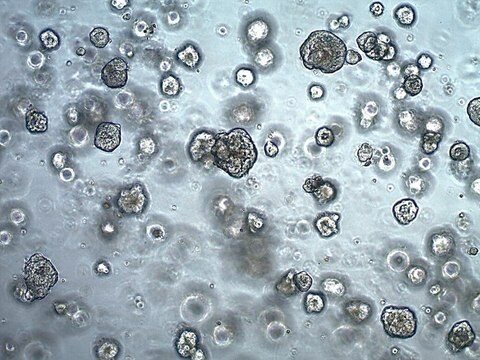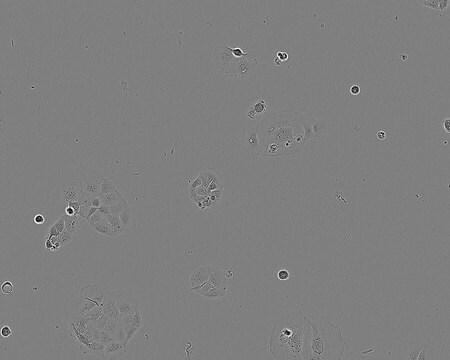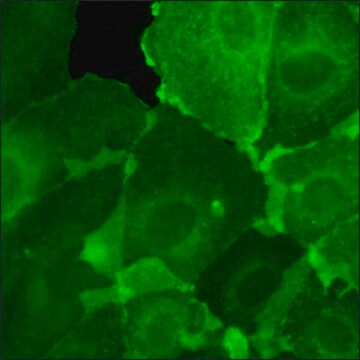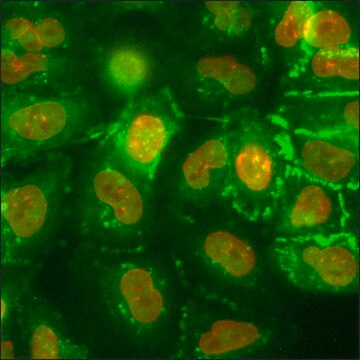CLLS1132
DLD1 CELLS AKT1 -/-
human male colon (Source Disease: Colorectal adenocarcinoma)
Faça loginpara ver os preços organizacionais e de contrato
About This Item
Código UNSPSC:
41106514
NACRES:
NA.81
Produtos recomendados
Descrição geral
DLD1 Cells SMAD4 -/- are colorectal adenocarinoma, epithelial cells, from a human adult male, with a ZFN knock out modification.
This product corresponds to ATCC Cat. No. CCL-221.
This product corresponds to ATCC Cat. No. CCL-221.
Aplicação
Media Renenewal changes two to three times per week.
Rapidly thaw vial by gentle agitation in 37°C water bath (~2 minutes), keeping vial cap out of the water. Decontaminate with 70% ethanol, add 9 mL culture media and centrifuge 125 x g (5-7 minutes). Resuspend in complete culture media and incubate at 37°C in a 5% CO2 atmosphere.
Subculture ratio: approx. 1:3 to 1:10.
The base medium for this cell line is RPMI, Cat. No. R5886. To make the complete growth medium, add the following components to the base medium: fetal bovine serum, Cat. No. F4135, to a final concentration (v/v) of 10%, L-glutamine, Cat. No. G7513, to a final concentration of 2 mM and sodium pyruvate, Cat. No. S8636, to a final concentration of 1 mM.
Cell freezing medium-DMSO 1X, Cat. No. C6164.
Rapidly thaw vial by gentle agitation in 37°C water bath (~2 minutes), keeping vial cap out of the water. Decontaminate with 70% ethanol, add 9 mL culture media and centrifuge 125 x g (5-7 minutes). Resuspend in complete culture media and incubate at 37°C in a 5% CO2 atmosphere.
Subculture ratio: approx. 1:3 to 1:10.
The base medium for this cell line is RPMI, Cat. No. R5886. To make the complete growth medium, add the following components to the base medium: fetal bovine serum, Cat. No. F4135, to a final concentration (v/v) of 10%, L-glutamine, Cat. No. G7513, to a final concentration of 2 mM and sodium pyruvate, Cat. No. S8636, to a final concentration of 1 mM.
Cell freezing medium-DMSO 1X, Cat. No. C6164.
Ações bioquímicas/fisiológicas
AKT serine/threonine kinase 1 (AKT1) acts as a regulator for cell-survival and anti-apoptotic actions, which are involved in development of various cancers. This protein has a crucial role in tumorigenesis. In mice, AKT1 is essential for normal development. Mutations in the gene are associated with the pathogenesis of prostate cancer (PC). Elevated expression of the gene has been observed in human gastric cancer. Aberrations in the AKT1 and glycogen synthase kinase 3 (GSK3)-β signaling leads to the development of schizophrenia.
Características e benefícios
These DLD-1 cells are adherent, with a doubling time of approx. 20 hours.
Zinc finger nuclease (ZFN) knock out on chromosome 14q32.3
Zinc finger nuclease (ZFN) knock out on chromosome 14q32.3
Qualidade
Tested for Mycoplasma, sterility, post-freeze viability, short terminal repeat (STR) analysis for cell line identification, PCR assay for cell line species confirmation.
Exoneração de responsabilidade
RESEARCH USE ONLY. This product is regulated in France when intended to be used for scientific purposes, including for import and export activities (Article L 1211-1 paragraph 2 of the Public Health Code). The purchaser (i.e. enduser) is required to obtain an import authorization from the France Ministry of Research referred in the Article L1245-5-1 II. of Public Health Code. By ordering this product, you are confirming that you have obtained the proper import authorization.
Somente componentes do kit
Nº do produto
Descrição
- DLD1 CELLS AKT1 -/-
Escolha uma das versões mais recentes:
Certificados de análise (COA)
Lot/Batch Number
It looks like we've run into a problem, but you can still download Certificates of Analysis from our Documentos section.
Se precisar de ajuda, entre em contato Atendimento ao cliente
Já possui este produto?
Encontre a documentação dos produtos que você adquiriu recentemente na biblioteca de documentos.
Association between single nucleotide polymorphisms in AKT1 and the risk of prostate cancer in the Chinese Han population.
Liu JM, et al.
Genetics and molecular research : GMR, 16(1) (2017)
Convergent evidence for impaired AKT1-GSK3β signaling in schizophrenia
Emamian ES, et al.
Nature Genetics, 36(2), 131-131 (2004)
Akt1/PKBalpha is required for normal growth but dispensable for maintenance of glucose homeostasis in mice
Cho H, et al.
The Journal of Biological Chemistry, 276(42), 38349-38352 (2001)
AKT plays a central role in tumorigenesis
Testa JR and Bellacosa A
Proceedings of the National Academy of Sciences of the USA, 98(20), 10983-10985 (2001)
Conteúdo relacionado
We have applied our revolutionary CompoZr Zinc Finger Nuclease technology to create an unparalleled range of genetically modified mammalian cell lines for use in areas, such as target validation, drug discovery and drug development.
Nossa equipe de cientistas tem experiência em todas as áreas de pesquisa, incluindo Life Sciences, ciência de materiais, síntese química, cromatografia, química analítica e muitas outras.
Entre em contato com a assistência técnica




